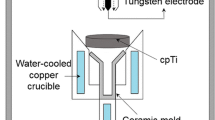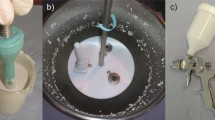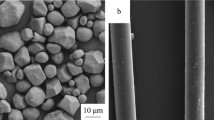Abstract
In this article, the chemical inertness of shell using Ti-added mullite backup coat against molten Ti-6Al-4V (Ti64) alloy was investigated. The metal/shell interfacial microstructures and compositions were characterized using an optical microscope, scanning electron microscope, roughness tester, and X-ray diffractometer; the hardened layer thickness was evaluated using a microhardness tester. By adding titanium powder into the mullite backup coat, the alpha case and hardened layer thickness of the Ti64 castings were largely reduced with good surface finishing. Silicon ions, from the backup coat, penetrated into the alloy and coarsened the β lath at the metal/shell interfacial area. The Ti powder in the mullite backup coat oxidized and interacted with silica during mold firing and casting, which reduced the silicon and oxygen concentrations at the metal/shell interfacial area. The oxygen penetration depth is thicker than the alpha case layer thickness, and around 0.26 wt pct, oxygen can obviously coarsen the alpha lath at the metal/shell interfacial area during investment casting.
Similar content being viewed by others
Avoid common mistakes on your manuscript.
1 Introduction
Titanium alloy, as known, has excellent specific strength, chemical inertness, corrosion resistance, and light weight, and it has been used as a structural material in the aerospace and automobile industry since the last century.[1–4] Because titanium alloy has a high reactivity and low fluidity at its melting temperatures, the most economical and widely used manufacturing method of titanium alloy is investment casting.[5] However, during investment casting, the mold materials were observed to decompose and give up oxygen, which causes a hard and brittle interaction layer with coarsened α lath (α case) formed at the metal/shell interfacial area.[6–8] Until the 1990s, yttria (Baimtec Material Co., Ltd., Beijing, China), with excellent chemical inertness against molten titanium alloy, was widely used as the facecoat material in investment casting titanium alloy.[6] Because yttria has high melting temperatures, it is difficult to sinter. The inappropriate preparation and sintering could result in loose microstructures of the yttria facecoat.[9] Meanwhile, yttria has poor thermal shock resistance;[10] the facecoat can easily crack and delaminate during shell making and casting processes. Different from the facecoat, the backup coats were only used to provide sufficient strength, permeability, and dimension accuracy for the casting molds,[11] so some cheap ceramics such as mullite (Baimtec Material Co., Ltd., Beijing, China), chamotte, and silica were often used as backup coat materials.[12,13] However, the Si in backup can penetrate through the facecoat during mold firing and the high-temperature investment casting process.[14–17] Hence, shells with multilayers of facecoats are normally used in industry but with an increasing mold preparation cost.
In 2013, Choi et al.[13,18] developed a new type of shell by adding titanium metal powders into an Al2O3 facecoat. Compared with using the pure Al2O3 facecoat, the addition of Ti powder enhanced the chemical inertness of the facecoat, and the α case layer thickness reduced from 350 μm to around 50 μm at the Ti casting surface. In order to improve the chemical inertness of the backup coat while reducing the number of facecoat layers, in this study, we carried out a study of the interaction between the Ti-6Al-4V alloy and the shell using a Ti-added backup coat.
2 Materials and Methods
2.1 Slurry and Mold
The slurries and molds were prepared at Baimtec Materials. Co. Ltd. The facecoat slurry was prepared by blending −200 mesh yttria powder (~75 µm) with zirconium acetate binder (made in-house; Baimtec Material Co., Ltd., Beijing, China), with an antifoam and a wetting agent. A fused yttria powder of 50/80 mesh was used as the facecoat stucco. The sub-backup coat of the MTi backup coat was made by mixing 5 wt pct Ti (200 mesh; Jinyi Coat Film Company, Jiangxi, China) with mullite powder (200 mesh). Colloidal silica was used as the backup coat binder, and mullite powder of 30/50 mesh was used as the backup coat stucco; the details of the backup coat formulations are listed in Table I. During preparation, the facecoat and backup coat were dried at 294 K (21 °C) and 50 pct relative humidity for 1 day and 8 hours, respectively. The slurries and stuccos were applied on the shell surface manually. After preparation, the wax inside the mold was dewaxed using the dewaxing cauldron at temperatures around 573 K (300 °C), and then the shells were fired at 1323 K (1050 °C) for 3 hours in air. The mold shape and test piece dimensions are shown in Figure 1.
2.2 Casting Metals
The Ti-6Al-4V alloy casting tubes are 70 × 70 × 100 mm with hollow dimensions of 30 × 30 × 100 mm (Figure 2(a)). Before casting, molds were first preheated at 723 K (450 °C); then the furnace was vacuumed to lower than 3.0 Pa. A charge of Ti64 alloy was melted to temperatures above 1973 K (1700 °C) and then cast using the gravity casting technique. After casting, tubes were cooled in air and the outside shell was removed manually. Figure 2(b) illustrates the tube surface conditions after using different backup coats. It can be seen that the tube surface after using the M backup coat is much rougher (some gray interaction products attached to the casting surface) than when using the MTi backup coat. At last, samples were obtained by cutting through the middle of the tube (Figure 2(a)).
2.3 Materials Characterization
After grinding and polishing, the cross sections of samples were etched using a Kroll solution (96 mL H2O + 3 mL HNO3 + 1 mL HF) followed by a 1 pct NH4F water solution. The alpha case at the metal/shell interface was observed using an optical microscope (OLYMPUS BX51 M), and the microstructures as well as the alloy interface area were analyzed using a scanning electrical microscope (FEI QUANTA 200F). The surface compositions of the castings were characterized using an X-ray diffractometer (XRD, D/max 2200PC, Japan). The microhardness profile at the metal-mold interface was obtained using a microhardness tester (Buehler micromet 6040), and the sample surface roughness was tested using a surface roughness tester (SRA-2 series, Shanghai Shangguang, China).
3 Results
3.1 Characterization of the Casting Tube Surface
The surface roughness of tubes using different backup coats is shown in Table II. As can be seen, both the R a and R z values of the tube using the MTi backup coat are much lower than those using the M backup coat. The high roughness of the tube using the M backup coat may correspond to the metal/shell interaction (Figure 2); by analyzing the surface compositions of the tubes (Figure 3), we found that they consisted of Y2O3, Ti, TiO2, and TiO. The detected intensity of Ti peaks on the tube surface when using the MTi backup coat was higher than when using the M backup coat, and the yttria peak intensity on the tube surface when using the MTi backup coat was lower than when using the M backup coat. Hence, the amount of Ti oxidation products and yttria residuals on the casting surface when using the M backup coat was greater than when using the MTi backup coat, which indicates that the metal/shell interfacial interaction between the mold using the M backup coat and the Ti64 alloy is much heavier than when using the MTi backup coat.
3.2 Microstructure of the Shell
The metal/shell interface microstructures after casting are shown in Figure 4. It can be seen that the Ti64 alloy consists of α + β phase, and due to the metal/shell interaction, a layer with bright contrast and coarsened α lath appears at the interface (alpha case). The alpha case thickness of the MTi shell is around 803 μm, and it is around 1367 μm when using M as the backup coat.
A closer look at the metal/shell interface area in Figure 5 shows that the average α lath thicknesses at the metal/shell interface of castings using M and MTi as the backup coats are 19.6 and 16.6 μm, respectively, both thicker than the Ti64 alloy matrix, which is around 4.3 μm. Besides coarsening the α lath, using the M backup coat, the β lath at the metal/shell interfacial area of the alloy also coarsened, with an average coarsening layer thickness of around 157 μm.
The energy-dispersive X-ray (EDX) line analysis result at the metal/shell interface in Figure 6 indicated that the β lath is rich in vanadium (V), whereas the α lath is rich in aluminum (Al). Besides V, Si also segregates into the β phase, and the Si penetration distance of the Ti64 casting using the M backup coat is around 162 μm, but nearly no Si ions were detected at the metal/shell interface of the casting when using the MTi backup coat. A comparison of the Si penetration distance (Figure 6(a)) and the β phase coarsening layer thickness (Figure 5(a)) shows that they have almost the same thickness.
3.3 Hardness of Metal/Alloy Interfacial Area
The hardness of the sample at the interfacial area is shown in Figure 7. As can be seen, the Ti64 casting has high hardness at a tube surface, e.g., of around 640 Hv when using the M backup coat and around 580 Hv when using the MTi backup coat. By increasing the distance away from the interface, the hardness of the alloy gradually decreased and finally stabilized at 375 Hv (Ti64 alloy matrix hardness). The hardened layer thickness is defined as the distance from the casting surface to the place where the hardness equals the matrix. Hence, the hardened layer thickness of the Ti64 casting using M as the backup coat is around 1450 μm and that using the MTi backup coat is around 850 μm.
4 Discussion
4.1 Effect of Ti in Backup Coat
Choi et al.[13] developed a new mold by adding Ti powder to Al2O3-based facecoat. He reported that the Ti powder in the Al2O3 facecoat can interact with oxygen (from Al2O3 or the environment) and Si (from binder) to form the titanium oxides and Ti5Si3 during shell firing, which largely reduces the alpha case thickness.[13] In this study, the Ti powder not only forms TiO2 during firing (Figure 8), but also interacts with Si, decomposition from silica binder (Baimtec Material Co., Ltd., Beijing, China), and mullite powder, forming a Si-rich layer outside the Ti particles (Figure 9, Table III). Thus, nearly no Si is detected in the penetration into the metal/shell interfacial area when using the MTi backup coat (Figure 6). As is known, Si is a eutectoid beta phase stabilizer,[19] and it will segregate into β phase during casting, which causes the coarsening of β lath (Figure 5). Hence, the thickness of the β-phase coarsening layer is the same as the Si penetration depth (Figure 6).
Due to the equation SiO2 → Si(Ti) + 2O(Ti), the reduced number of reactive SiO2 particles in the mullite shell also correlates to a reduction of oxygen, so the thicknesses of both the α case and the hardened layers of the alloy when using the MTi shell are shorter than those using M shells (Figure 4).
4.2 Comparison of α Case Thickness and Predicted Oxygen Penetration Distance
According to the research by Boettinger et al.[20] and Chan et al.,[21] the hardness of the Ti64 alloy and the solid-solution oxygen concentration in T64 alloy follow a linear relationship:
where b 0 and b 1 are empirical contents, which equal 374.5 (matrix hardness) and 50.5, respectively; the oxygen concentrations at different depths from the metal/shell interface toward the metal matrix are shown in Figure 10.
The oxygen penetration distances in Figure 10 are slightly thicker than the hardened layer thickness and alpha case thickness in both samples. Comparing the oxygen concentrations at different distances with the alpha case thickness, around 0.26 wt pct oxygen in the molten Ti64 alloy can obviously coarsen the α lath at the metal/shell interface during investment casting, which is also confirmed by Gaddam.[22]
5 Conclusions
Use of Ti powder in the mullite shell can reduce the alpha case and hardened layer thickness at the metal/shell interface. Titanium powder oxidized and interacted with Si and O in mullite shell, which reduced the Si penetration distance as well as the oxygen penetration distance when using the MTi backup coat.
-
1.
Solid solution Si at the metal/shell interface mostly segregated into the β phase with a coarsened β lath when using the M backup coat, and nearly no β phase coarsening was observed at the metal/shell interfacial area when using MTi as the backup coat.
-
2.
Oxygen penetration depth was deeper than the measured alpha case thickness, and around 0.26 wt pct oxygen, it was observed to cause alpha lath coarsening at the metal/shell interfacial areas during investment casting.
References
M. Niinomi: Materials Science and Engineering: A, 1998, vol.243, pp. 231-236.
L. Reclaru,J. M. Meyer: Journal of Dentistry, 1994, vol.22, pp. 159-168.
C. Cui, B. Hu, L. Zhao,S. Liu: Materials & Design, 2011, vol.32, pp. 1684-1691.
R. R. Boyer: Materials Science and Engineering: A, 1996, vol.213, pp. 103-114.
A. Mitchell: Materials Science and Engineering: A, 1998, vol.243, pp. 257-262.
R. L. Saha, T. K. Nandy, R. D. K. Misra,K. T. Jacob: Metallurgical Transactions B, 1990, vol.21, pp. 559-566.
S.-Y. Sung,Y.-J. Kim: Materials Science and Engineering: A, 2005, vol.405, pp. 173-177.
Y. Guilin, L. Nan, L. Yousheng,W. Yining: The Journal of Prosthetic Dentistry, 2007, vol.97, pp. 157-164.
G. Bernard-Granger, C. Guizard,L. San-Miguel: Journal of the American Ceramic Society, 2007, vol.90, pp. 2698-2702.
G. A. Gogotsi: Refractories, 1993, vol.34, pp. 539-547.
C. Yuan,S. Jones: Journal of the European Ceramic Society, 2003, vol.23, pp. 399-407.
C. Yuan, X. Cheng, G. S. Holt, D. Shevchenko,P. A. Withey: Ceramics International, 2015, vol.41, pp. 4129-4139.
B.-J. Choi, S. Lee,Y.-J. Kim: Journal of Materials Engineering and Performance, 2014, vol.23, pp. 1415-1423.
C. Yuan, D. Compton, X. Cheng, N. Green,P. Withey: Journal of the European Ceramic Society, 2012, vol.32, pp. 4041-4049.
X. Cheng, C. Yuan, D. Shevchenko,P. Withey: Materials Chemistry and Physics, 2014, vol.146, pp. 295-302.
C. Yuan, X. Cheng,P. A. Withey: Materials Chemistry and Physics, 2015, vol.155, pp. 205-210.
X. Cheng, X. D. Sun, C. Yuan, N. R. Green,P. A. Withey: Intermetallics, 2012, vol.29, pp. 61-69.
B. J. Choi, S. Lee,Y. J. Kim: Materials Science and Technology, 2013, vol.29, pp. 1453-1462.
G. Lütjering, J. C. Williams: Titanium, 2nd ed., Springer-Verlag, Berlin, 2007, p. 24.
W. J. Boettinger, M. E. Williams, S. R. Coriell, U. R. Kattner,B. A. Mueller: Metallurgical and Materials Transactions B, 2000, vol.31, pp. 1419-1427.
K. S. Chan, M. Koike, B. W. Johnson,T. Okabe: Metallurgical and Materials Transactions A, 2008, vol.39, pp. 171-180.
R. Gaddam, B. Sefer, R. Pederson,M.-L. Antti: Materials Characterization, 2015, vol.99, pp. 166-174.
Acknowledgments
This article is financially supported by the Chinese Postdoctoral Science Foundation (Grant No. 2014M550587) and the Aeronautics Fundamental Science Foundation of China (Grant No. 2010ZF51068). Many thanks for the experimental assistance from the Institute of Aeronautical Materials in Beijing.
Author information
Authors and Affiliations
Corresponding author
Additional information
Manuscript submitted July 29, 2015.
Rights and permissions
About this article
Cite this article
Cheng, X., Chai, L., Wu, G. et al. Evaluation of Interfacial Interactions Between Ti-6Al-4V and Mold Use Ti-Added Backup Coat in Investment Casting. Metall Mater Trans A 47, 2313–2318 (2016). https://doi.org/10.1007/s11661-016-3393-y
Published:
Issue Date:
DOI: https://doi.org/10.1007/s11661-016-3393-y














